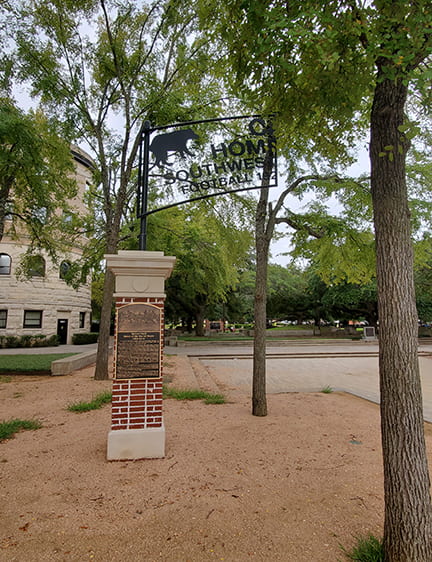This piece by former Texas Collection director Kent Keeth was originally published in The Baylor Line in January 1990. Blogging About Texas periodically features selections from Looking Back at Baylor, with hopes of sharing Keeth’s work with a new audience.
As Baylor prepares for a shortened and socially distanced football season due to COVID-19, McLane Stadium will host the fewest number of fans since its opening in 2014. Capacity for McLane is listed at 45,140, the 25% allowed this season is only 11,285. The last time max capacity for Baylor Football was so low, the Bears played at Carroll Field which held about 12,000 fans during the 1930s. Read on to learn more about the legacy of Carroll Field.
Harvard has its ‘Soldiers Field,’ . . . Princeton its ‘Franklin Field’ and Baylor will have its ‘Lee Carroll Field,”’ boasted the Lariat on January 17, 1902. The campus newspaper was reporting an offer made to the university’s Athletic Association by athletics business manager Lee Carroll, who challenged students to raise $600 in order to receive his matching gift of $1,000 toward the creation of a sports arena.
At the turn of the century, when collegiate athletics were only just becoming established in Texas, specialized facilities for them were still relatively rare. At the time of Carroll’s offer, Baylor football was played on vacant lots where grass was minimal, weeds were rampant, and sandburs provided a powerful incentive to avoid being tackled. The designation of a purpose-built athletics facility would not only raise the school’s standards of competition, but would also give Baylor bragging rights relative to its peer institutions.
The university community responded to the challenge, and by fall Carroll Field was in use. Situated directly behind the new science building, its length extended as far as the banks of Waco Creek. At first it was little more than an open space along whose sidelines standing spectators ranged themselves. Not until 1915 was a grandstand erected on the west side, anchored to the sloping side of a wedge-shaped brick athletics building that housed dressing rooms, equipment storage, and coaching facilities. The area served for football, baseball, track, and assorted other sports, and while various circumstances would require temporary off-campus relocations of large events, Carroll Field constituted the true center of Baylor athletics until it was dismantled in 1940.
Though the field has been gone for fifty years, memories of it remain vivid to those who knew it. Former bookstore manager Bob Bright ’46, who grew up near the campus, remembers joining with other neighborhood children to watch games through knotholes in the field’s wooden fence; and retired mathematics and religion professor P. D. Browne ’21 recalls helping to erect that same fence during his student days. One prominent university benefactor who served as trainer for the football team during the 1930s still relives his embarrassment as the players removed his trousers in the end zone, under the fascinated gaze of coeds who watched from windows on the upper floors of the science building.
While the Lariat may originally have overstated Carroll Field’s significance in relation to the facilities of eastern universities, news of it did occasionally trickle through the Ivy League. On February 22, 1926, Baylor graduate Dixon Westor ’25 took time off from his graduate studies at Yale to write to former Baylorite Silas Vance at Harvard about “the fire which burned the [Carroll Field] athletic building down and the sweater of Mr. [Assistant Coach Jim] Crow off.”
The net effect of that fire, which had occurred on the night of February 10, was the reconstruction of the athletics building on a scale 50 percent larger, which also served to increase the limited seating capacity. During the field’s heyday in the 1920s and 1930s, further construction would eventually expand its permanent seating to 12,000 places, with temporary bleachers available to accommodate three thousand more in the end zones.
As the physical plant of the campus expanded, however, the university could no longer afford to devote so large and so central an area to athletics. Construction of Pat Neff Hall in 1939 crowded the western boundary of the field very closely, while the site selected for the new student union building impinged upon the gridiron itself.
In the summer of 1940, the Lariat rounded out Carroll Field’s history by reporting that its bleachers, grandstands, and walls were in the process of being leveled. Today — apart from the memories — only two known relics survive. Several courses of brickwork from the athletics building, uncovered during excavations for the Vera Martin Daniel Fountain Plaza, lie reburied under paving stones near Pat Neff Hall; and the elaborate sign from the Fifth Street gate which proclaimed Carroll Field as the “Home of Baylor Bears” still inclines, half a century later, against a wall in one of the university’s warehouses.



The Fifth Street entrance is now marked by a brick column and partial replica arch in Vera Martin Daniel Plaza (Traditions Square). The original arch was refurbished in 2018 and now resides in the Bill Daniel Student Center. Find out more in the Baylor Proud post “The story behind the Carroll Field sign in the Baylor SUB.” https://www2.baylor.edu/baylorproud/2018/10/the-story-behind-the-carroll-field-sign-in-the-baylor-sub/
No Comments